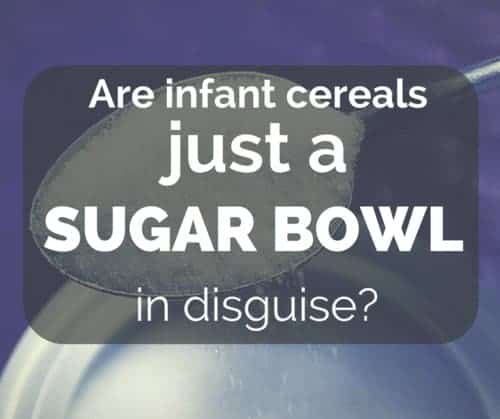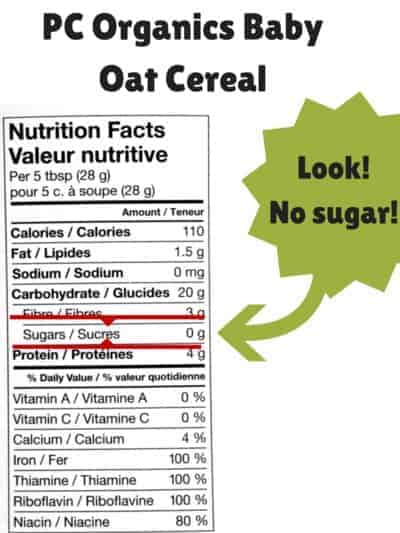
Welcome to Part 1 of my 8 part series: A Dietitian’s Guide to Baby Cereal. My goal in writing this series is to provide you with the education you need about these cereals to make an informed choice about when and what cereals you’d like to feed your baby. To stay connected with me and receive updates on this series, subscribe via RSS, or like Smart Nutrition on facebook!
Part 2: A Brief History of Baby Cereal
Part 3: The Pros and Cons of Baby Cereal
Part 4: Can Babies Digest the Starch in Baby Cereal?
Part 5: Should I Make My Own Baby Cereal?
Part 6: How to Choose the Right Baby Cereal
Part 7: Myths About Baby Cereal
Part 8: 5 Ways to Use Baby Cereal
Are Baby Cereals Just Sugar Bowls in Disguise?
I was inspired to write this series by some misleading information some readers sent my way. Apparently there is some concern out there that baby cereals are high in sugar. The fear-mongering website of Joseph Mercola warns you:
[blockquote cite=”Joseph King-of-Misinformation Mercola” type=”center”]“When you feed your baby a bowl of infant cereal, picture yourself dipping directly into your sugar bowl and feeding baby a spoon or two, because that’s essentially what it amounts to.”[/blockquote]
This same website then proceeds to recommend several alternatives, one of which is cooked carrots. So I decided to do some nutrition investigation and compare the two. I can’t resist a good nutrition investigation.
| % of calories | Cooked Carrots | Rice Baby Cereal prepared with Whole Milk |
| Carbs | 86.8% | 58% |
| Sugar | 40% | 20% |
| Fat | 4.6% | 28% |
| Protein | 8.7% | 14% |
Carrots have 150% HIGHER percentage of calories from carbs than the prepared infant cereal!
Carrots have 200% HIGHER percentage of calories from sugar than the prepared infant cereal!
So, with this new information, allow me to rewrite the quote above:
[blockquote cite=”Jessica Worried-You’ll-Take-This-Seriously Penner” type=”center”]“When you feed your baby a bowl of cooked carrots, picture yourself dipping directly into your sugar bowl and feeding baby several spoonfuls, because that’s essentially what it amounts to.”[/blockquote]
Nobody thinks they’re feeding pure sugar to their kids when they give them carrots, because they aren’t. You have to look at the food as a whole: carrots also contain fibre, which helps to slow down the absorption of the sugar into the bloodstream and keeps a person feeling fuller for longer.
Likewise with the baby cereal. You have to look at the food as a whole: breastmilk or infant formula is added when the cereals are prepared. These contain fat and protein, which also help to slow down the absorption of sugar into the bloodstream and keep a person feeling fuller for longer.
Where does the sugar come from in baby cereal?
A package of baby cereal contains NO SUGAR. In the above comparison, the 20% of calories that come from sugar is from naturally occurring sugars in the added milk. The cereal also contains starches that will break down into sugar, but so do cooked carrots. In fact, carrots have more starch than baby cereal.
No, baby cereals are definitely not just a sugar bowl in disguise. Have you been turned off of baby cereals because of this myth, or something else you’ve heard about them? Comment below!
Part 2: A Brief History of Baby Cereal
Part 3: The Pros and Cons of Baby Cereal
Part 4: Can Babies Digest the Starch in Baby Cereal?
Part 5: Should I Make My Own Baby Cereal?
Part 6: How to Choose the Right Baby Cereal
Part 7: Myths About Baby Cereal
Part 8: 5 Ways to Use Baby Cereal
[share title=”Share This Article” facebook=”true” twitter=”true” google_plus=”true” linkedin=”true” pinterest=”true” reddit=”true” email=”true”]



Thank you for this article! I live in USA. I have been stressing about what to feed my 19 week old baby first. Rice cereal is recommended but I’ve read about it containing high amounts of inorganic arsenic. Not sure if this is true but its enough to scare me away from feeding it to him. We’ve been trying oatmeal instead.
Yes, there could be higher levels of arsenic in rice cereal, which is why I like to rotate through the different grains. And then, that way, you ‘re also exposing your baby to a wider variety of foods!
To my readers: a critical comment was left on this article, which I haven’t approved because it was left anonymously and contained no question or comment relevant to the content of the article. That being said, I encourage both the person who made it and anyone else with questions or critiques regarding my articles to comment using your name and email address. Also, please address something specific about what I’ve said, so we can have a mutually enlightening conversation. Because, while it may be entertaining, suggesting that my degree is from a Cracker Jack box (rather than the nationally accredited University of Manitoba) does nothing to prove any point, or educate anybody on nutrition, which is what this site is all about!
Interesting article! My kids are older now, but I always used breast milk mixed into the cereal.
Thanks for the comment! I would have preferred to do the comparison using breastmilk mixed into the cereal but the Canadian Nutrient File didn’t have that option 🙂 Breastmilk is lower in protein than cow’s milk. If you want to read more about infant cereal, make sure to follow the blog on Facebook to get links to the following articles in the series!